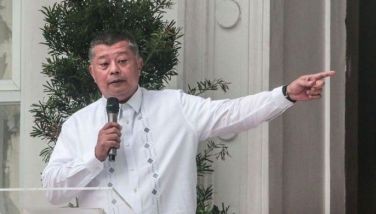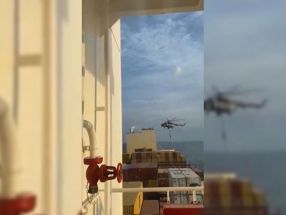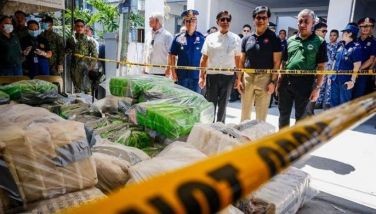AFP to reopen Subic as Navy, PAF base DND: Irreversible crisis has reached tipping point
MANILA, Philippines - The Philippine Air Force and Navy will go ahead with a plan to open camps in Subic Bay Freeport facing the disputed South China Sea and West Philippine Sea even if a proposed American military presence doesn’t happen, Defense Secretary Voltaire Gazmin said yesterday.
Gazmin unveiled plans two years ago to open air force and navy camps at the Freeport so fighter jets and frigates can respond faster to any contingency in the disputed waters where the Philippines has been facing an assertive China, which claims most of the area.
The Philippines signed an expanded defense cooperation agreement with the US last year to allow allied American forces to temporarily station at camps including Subic, but the pact became uncertain after left-wing groups questioned its constitutionality at the Supreme Court.
While a US military presence in the camps would help, Gazmin said the government would proceed to construct the bases soon even if the court eventually decides against access for US troops.
The Philippines has scrambled to modernize its military, one of Asia’s weakest. It has bought 12 new South Korean fighter jets with the first two to be delivered later this year and stationed at Subic, Gazmin said.
Subic Bay, about 80 kilometers northwest of Manila, used to host Washington’s largest naval base outside the American mainland until it was closed down in 1992, ending nearly a century of US military presence.
Three years after, China seized a strategic reef also claimed by Manila, prompting Philippine senators to ratify the pact that allowed American forces to return for annual combat drills.
Roberto Garcia, Subic Bay Metropolitan Authority chairman, said an airport and seaport will have a dual military-civilian use.
Businesses, including hotels and restaurants, would likely back the return of military personnel, he said.
American personnel from the USNS Mercy, a huge hospital ship docked in Subic for an annual humanitarian mission, swarmed shopping malls and restaurants. “There was a guy who brought two Christmas lanterns to his ship,” Garcia said.
Japan joins drill
Also in Subic Bay, Japan has joined US-led maritime humanitarian exercises the first time, as concerns over China’s growing assertiveness grow.
A Japanese navy replenishment ship was in Subic Bay, a former US naval base, to refuel a US Navy floating hospital en route to Vietnam for the seven-nation humanitarian mission.
It was the first time a Japanese navy ship has taken part in the humanitarian assistance and disaster relief drills although a flotilla of Japanese training vessels, including a submarine, makes annual port calls in Manila.
Rear Admiral Charles Williams, commander of US Seventh Fleet’s Task Force 73, said humanitarian assistance and disaster relief exercises were becoming a regular component of military exercises in the Philippines.
“You are seeing in exercises ... a shift from strictly bilateral engagement to multilateral, which is why you see the Japanese here today,” Williams told journalists aboard USNS Mercy, one of two US hospital ships.
China claims most of the South China Sea, through which $5 trillion in ship-borne trade passes every year. The Philippines, Vietnam, Malaysia, Taiwan and Brunei also have overlapping claims. Japan and China also have conflicting claims in the East China Sea.
Williams said the presence of Admiral Katsutoshi Kawano, head of Japan’s Self-Defence Forces, “speaks volumes about their commitment to the region and their commitment to being part of a multilateral engagement.”
Kawano met Wednesday with Armed Forces chief General Hernando Iriberri, and Gazmin at Camp Aguinaldo, where he expressed interest in holding joint amphibious landing exercises and operations with Philippine marines.
In a meeting with Gazmin, Kawano also expressed interest in sharing information in the South China Sea and capacity building, particularly in humanitarian assistance and disaster relief.
Williams said humanitarian assistance and disaster relief operations were “a great avenue towards increasing maritime stability and security in this region,” part of Washington’s rebalance to Asia policy.
While welcoming Japan’s military plans, Gazmin stressed a Visiting Forces Agreement (VFA) is needed before any joint military undertaking can be allowed on Philippine soil.
“The defense secretary has welcomed Admiral Kawano’s interests in more activities with the Philippines, emphasizing that with regard to conducting such activities, a VFA with Japan would be needed,” DND spokesman Peter Paul Galvez said.
In the absence of the VFA, Japan and the Philippines would make do with a Memorandum on Defense Cooperation and Exchanges.
“Aside from defense equipment cooperation, Admiral Kawano also stressed the importance of capacity building cooperation with the Philippines, particularly on matters concerning Humanitarian Assistance and Disaster Response,” Galvez said.
Tipping point
China is taking the region to the “tipping point” of an “irreversible crisis” with its plan to build what it calls search and rescue facilities on its newly built artificial islands in the West Philippine Sea, Galvez also said yesterday.
“Maybe we should ask: ‘For whom are those search and rescue facilities for?’ Is it for our ships and installations that they are threatening to destroy?” Galvez said in a text message.
“It must be stopped otherwise it will be the tipping point that will plunge the entire region including the peace-loving Chinese communities into a deeper and irreversible crisis,” he said.
Galvez said such facilities are actually elements of China’s “island building militarization that needs to stop and be dismantled.”
“Regardless of what supposedly ‘good’ details the Chinese leadership informs the peace-focused and rules-based international community, they illegally and blatantly continue with their aggression,” he added.
“They are simply trying to cover their tracks. This is the worst stage of all, this is the militarization stage,” the defense official said.
To strengthen its claim in the South China Sea, China built artificial islands on seven reefs also being claimed by the Philippines.
The construction projects are on Panganiban (Mischief), Zamora (Subi), Kagitingan (Fiery Cross), Kennan (Chigua), Mabini (Johnson South), Burgos (Gaven) and Calderon (Cuarteron) Reefs.
The international community – including the United States and the European Union – has expressed alarm over China’s reclamation activities. Beijing is unperturbed.
Philippine officials said China’s reclamation is a violation of the 2002 Declaration on the Conduct of Parties in the South China Sea, which bars claimant states from engaging in activities than can complicate the situation.
On Tuesday, Chinese Ambassador Zhao Jianhua announced that China is planning to build facilities on reclaimed reefs to support freedom of navigation, search and rescue efforts and scientific research. Alexis Romero, Jaime Laude, AP
- Latest
- Trending



























